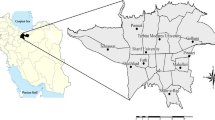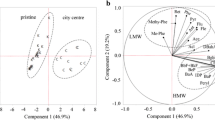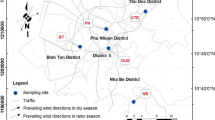Abstract
Polycyclic aromatic hydrocarbons (PAHs) are ubiquitous pollutants in the urban atmosphere. An investigation of PAHs in the urban atmosphere of Tehran, Iran, was conducted in this study. Car engine air filters (CAFs) were collected in 15 taxi garages between 2016 and 2017 and analyzed for PAHs to assess the concentration level and health risks of polycyclic aromatic hydrocarbons (PAHs). The total concentrations of 16 PAHs (ΣPAHs) ranged from 169 to 174 μg/CAF. The average ΣPAHs concentration in winter was slightly higher than in summer. The most abundant individual PAH was phenanthrene, followed by fluoranthene, pyrene, and naphthalene. Concentrations of benzo[a]pyrene (BaP) varied between 1.80 and 2.27 μg/CAF. Based on estimated air volumes that pass through each CAF, atmospheric PAHs were estimated. ΣPAHs ranged from 8.31 to 8.39 ng/m3 for the average air volume estimate, less than those reported before using a high volume air sampler. The total carcinogenic risk of 16 PAH compounds was less than the acceptable limit of EPA for human health (1 × 10−6).


Similar content being viewed by others
References
Ahmadipour F, Esmaeili Sari A, Bahramifar N (2019) Characterization, concentration and risk assessment of airborne particles using car engine air filter (case study: Tehran metropolis). Environ Geochem Health. https://doi.org/10.1007/s10653-019-00319-10123456789
Alizadeh-Choobari O, Bidokhti AA, Ghafarian P, Najafi MS (2016) Temporal and spatial variations of particulate matter and gaseous pollutants in the urban area of Tehran. Atmos Environ 141:443–453
Atash F (2007) The deterioration of urban environments in developing countries: mitigating the air pollution crisis in Tehran, Iran. Cities 24(6):399–409
Bari MA, Baumbach G, Kuch B, Scheffknecht G (2010) Particle-phase concentrations of polycyclic aromatic hydrocarbons in ambient air of rural residential areas in southern Germany. Air Qual Atmos Health 3:103–116
Cai QY, Xiao PY, Lü H, Katsoyiannis A, Tian JJ, Zeng Y, Mo CH (2014) Evaluation of car air filters’ efficiency as active samplers for polycyclic aromatic hydrocarbons and heavy metals. Aeros Air Qual Res 14:431–439
Cecinato A (1997) Polynuclear aromatic hydrocarbons (PAH), benz(a)pyrene (BaPY) and nitrated-PAH (NPAH) in suspended particulate matter. Ann Chim 87:483–496
Fang G-C, Chang K-F, Lu C, Bai H (2004) Estimation of PAHs dry deposition and BaP toxic equivalency factors (TEFs) study at urban, Industry Park and rural sampling sites in Central Taiwan, Taichung. Chemosphere 55(6):787–796
Gao B, Yu JZ, Li SX, Ding X, He QF, Wang XM (2011) Roadside and rooftop measurements of polycyclic aromatic hydrocarbons in PM2.5 in urban Guangzhou: evaluation of vehicular and regional combustion source contributions. Atmos Environ 45:7184–7191
Gope M, Masto RE, George J, Hoque RR, Balachandran S (2017) Bioavailability and health risk of some potentially toxic elements (Cd, Cu, Pb and Zn) in street dust of Asansol, India. Ecotoxicol Environ Saf 138:231–241
Hadad K, Mehdizadeh, S.,& Sohrabpour, M. (2003) Impact of different pollutant sources on shiraz air pollution using SPM elemental analysis. Environ Int 29:39–43
Halek F, Nabi G, Kavousi A (2008) Polycyclic aromatic hydrocarbons study and toxic equivalency factor (TEFs) in Tehran, IRAN. Environ Monit Assess 143:303–311
Hien TT, Nam PP, Yasuhiro S, Takayuki K, Norimichi T, Hiroshi B (2007) Comparison of particle-phase polycyclic aromatic hydrocarbons and their variability causes in the ambient air in Ho Chi Minh City, Vietnam and in Osaka, Japan, during 2005–2006. Sci Total Environ 382:170–181
Hoseini M, Yunesian M, Nabizadeh R, Yaghmaeian K, Ahmadkhaniha R, Rastkari N, Parmy S, Faridi S, Rafiee A, Naddafi K (2015) Characterization and risk assessment of polycyclic aromatic hydrocarbons (PAHs) in urban atmospheric particulate of Tehran, Iran. Environ Sci Pollut Res. https://doi.org/10.1007/s11356-015-5355-0
Hu T, Zhang J, Xing X, Zhan C, Zhang L, Liu H, Liu T, Zheng J, Yao R, Cao J (2018) Seasonal variation and health risk assessment of atmospheric PM2.5-bound polycyclic aromatic hydrocarbons in a classic agglomeration industrial city, Central China. Air Qual Atmos Health. https://doi.org/10.1007/s11869-018-0575-3
IARC (International Agency for research on cancer) (2011) Agents Classified by the IARC Monographs, 1–102
Katsoyiannis A, Birgul A, Ratola N, Cincinelli A, Sweetman AJ, Jones KC (2012) Can car air filters be useful as a sampling medium for air pollution monitoring purposes? Environ Int 48:65–70
Liu S, Tao S, Liu W, Dou H, Liu Y, Zhao J, Little MG, Tian Z, Wang J, Wang L, Gao Y (2008) Seasonal and spatial occurrence and distribution of atmospheric polycyclic aromatic hydrocarbons (PAHs) in rural and urban areas of the North Chinese Plain. Environ Pollut 156:651–656
Liu J, Man M, Ma S, Li J, Wu Q, Peng J (2015) Atmospheric levels and health risk of polycyclic aromatic hydrocarbons (PAHs) bound to PM2.5 in Guangzhou, China. Mar Pollut Bull 100:134–143
Liu X, Wang Z, Bai H, Zhang S, Mu L, Peng L (2020) Characteristics and health risk assessments of heavy metals in PM2.5 in Taiyuan and Yuci college town, China. Air Quali Atmos Health. https://doi.org/10.1007/s11869-020-00860-4
Long Y, Dai T, Wu Q (2013) Sources and distribution of polycyclic aromatichydrocarbons in street dust from the Chang-Zhu-Tan Region, Hunan, China. Environ Monit Assess 185:1377–1390
Mari M, Schuhmacher M, Feliubadaló J, Domingo JL (2008) Air concentrations of PCDD/Fs, PCBs and PCNs using active and passive air samplers. Chemosphere 70(9):1637–1643
Martellini T, Giannoni M, Lepri L, Katsoyiannis A, Cincinelli A (2012) One year intensive PM2.5 bound polycyclic aromatic hydrocarbons monitoring in the area of Tuscany, Italy. Concentrations, source understanding and implications. Environ Pollut 164: 252–258
Moeinaddini M, Esmaili Sari A, Riyahi Bakhtiari A, Yiu-Chung Chan A, Mohammad Taghavi S, Hawker D, Connell D (2014) Source apportionment of PAHs and n-alkanes in respirable particles in Tehran, Iran by wind sector and vertical profile. Environ Sci Pollut Res 21:7757–7772
Nisbet JCT, LaGoy PK (1992) Toxic equivalence factors (TEFs) for polycyclic aromatic hydrocarbons (PAHs). Regul Toxicol Pharmacol 16:290–300
Piccardo MT, Stella A, Pala M, Balducci D, Valerio F (2010) Field use of semipermeable membrane devices (SPMDs) for passive air sampling of polycyclic aromatic hydrocarbons: opportunities and limitations. Atmos Environ 44(16):1947–1951
Rivera BH, Rodriguez MG (2016) Characterization of airborne particles collected from Car engine air filters using SEM and EDX techniques. Inter J Environ Res Public Health. https://doi.org/10.3390/ijerph13100985
Rezaei F, Kakooei H, Ahmadkhaniha R, Azam K, Omidi L, Shahtaheri SJ (2018) Inhalation exposure and health risks for newsagents exposed to atmospheric polycyclic aromatic hydrocarbons in Tehran, Iran. Urban Clim 24:796–802
Saeedi M, Li LY, Salmanzadeh M (2012) Heavy metals and polycyclic aromatic hydrocarbons: pollution and ecological risk assessment in street dust of Tehran. J Hazard Mater 227–228:9–17
Soltani N, Keshavarzi B, Moore F, Tavakol T, Lahijanzadeh AR, Jaafarzadeh N, Kermani M (2015) Ecological and human health hazards of heavy metals and polycyclic aromatic hydrocarbons (PAHs) in road dust of Isfahan metropolis, Iran. Sci Total Environ 505:712–723
Taghvaee S, Sowlat MH, Hassanvand MS, Yunesian M, Naddafi K, Sioutas S (2018) Source-specific lung cancer risk assessment of ambient PM2.5-bound polycyclic aromatic hydrocarbons (PAHs) in Central Tehran. Environ Int 120:321–332
Tan J-H, Bi X-H, Duan J-C, Rahn KA, Sheng G-Y, Jia-Mo F (2006) Seasonal variation of particulate polycyclic aromatic hydrocarbons associated with PM10 in Guangzhou, China. Atmos Res 80(4):250–262
USEPA (2005) Guidelines for carcinogen risk assessment. Risk Assessment Forum U.S. Environmental Protection Agency, Washington, DC Available at: www3.epa.gov/airtoxics/cancer_guidelines_final_3-25-05.pdf
USEPA (1984) Guidelines establishing test procedures for the analysis of pollutants under clean water act: method 610 – polynuclear aromatic hydrocarbons. Environmental Protection Agency, Washington (DC), pp 43344–43352
USEPA (1993) Provisional guidance for quantitative risk assessment of polycyclic aromatic hydrocarbons. NC EPA-600/R-93/089.US Environmental Protection Agency, Research Triangle Park
Valavanidis A, Fiotakis K, Vlahogianni T, Bakeas EB, Triantafillaki S, Paraskevopoulou V, Dassenakis M (2006) Characterization of atmospheric particulates, particle-bound transition metals and polycyclic aromatic hydrocarbons of urban air in the Centre of Athens (Greece). Chemosphere 65(5):760–768
Van Drooge BL, Fernández P, Grimalt JO, Stuchlík E, Torres García CJ, Cuevas E (2010) Atmospheric polycyclic aromatic hydrocarbons in remote European and Atlantic sites located above the boundary mixing layer. Environ Sci Pollut Res 17:1207–1216
Wang XS (2017) Polycyclic aromatic hydrocarbons in urban street dust: sources and health risk assessment. Environ Geochem Health. https://doi.org/10.1007/s10653-017-9918-5
Yu B, Xie X, Ma LQ, Kan H, Zhou Q (2014) Source, distribution, and health risk assessment of polycyclic aromatic hydrocarbons in urban street dust from Tianjin, China. Environ Sci Pollut Res 21:2817–2825
Zhang J, Zhan C, Liu H, Yao R, Hu T, Xiao W, Xing X, Xu H, Cao J (2016) Characterization of polycyclic aromatic hydrocarbons (PAHs), iron and black carbon within street dust from a steel Industrial City, Central China. Aeros Air Qual Res 16:2452–2461
Funding
This study was funded by the Department of Environmental Sciences, Faculty of Natural Resources, Tarbiat Modares University, Noor, Mazandaran, Iran. It is hoped that the results obtained will give a baseline reference for regulatory actions aiming at the improvement of air quality in the metropolis of Tehran.
Author information
Authors and Affiliations
Corresponding author
Additional information
Publisher’s note
Springer Nature remains neutral with regard to jurisdictional claims in published maps and institutional affiliations.
Rights and permissions
About this article
Cite this article
Ahmadipour, F., Sari, A.E. & Bahramifar, N. Characterization and health risk assessment of particulate-bound polycyclic aromatic hydrocarbons in Tehran, Iran. Air Qual Atmos Health 13, 1431–1438 (2020). https://doi.org/10.1007/s11869-020-00897-5
Received:
Accepted:
Published:
Issue Date:
DOI: https://doi.org/10.1007/s11869-020-00897-5




